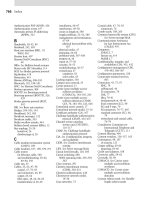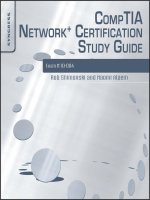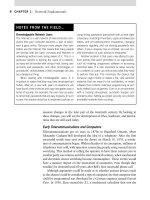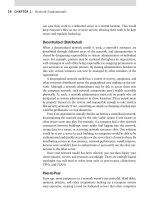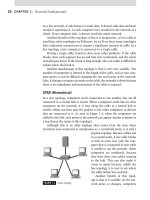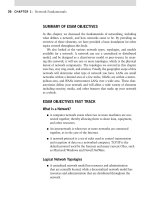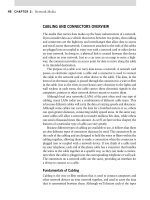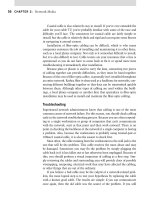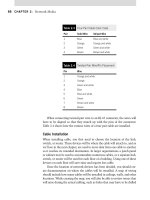CompTIA Network+ Certification Study Guide part 76 pdf
Bạn đang xem bản rút gọn của tài liệu. Xem và tải ngay bản đầy đủ của tài liệu tại đây (126.83 KB, 10 trang )
Appendix C
736
When planning and establishing your local policies and procedures 14.
you have to recognize that some state and/or federal regulations
might apply to your organization. You are working at the local
county hospital, which of the following regulations should your
organization need to be aware of?
A. Health Insurance Portability and Accountability Act (HIPAA)
B. Sarbanes-Oxley Act of 2002
C. ISO/IEC 27002:2005
D. All of the above
Correct answer and explanation: D. All of the above is correct. Since you
are working at a hospital you must comply with HIPAA. As a private busi-
ness you must comply with the financial regulations in the Sarbanes-Oxley
Act of 2002. As an organization that has computer networks and recognizes
information security as an important role in how to develop your networks,
you must be aware of ISO/IEC 27002:2005. Regulations are important to
how you plan and establish your local policies and procedures. Many orga-
nizations are held to state and federal regulations which will affect their
responsibilities as a public/private, for-profit or not-for-profit business.
Understanding what regulations your organization must adhere to will help
you manage how your network operates.
Incorrect answers and explanations: A, B, C. Health Insurance Portability
and Accountability Act (HIPAA), Sarbanes-Oxley Act of 2002, and ISO/IEC
27002:2005 regulations are by themselves incorrect answers. You must recog-
nize, be aware, and comply with all of these regulations, not just one of them.
You have been delegated the responsibility of creating all of your 15.
networks documentation. As you research this topic you find out
that you must create configuration management documentation.
What types of configuration management documentation must you
create?
A. Wiring schematics, physical/logical network diagrams, baselines,
policies, procedures, configurations, and regulations
B. Wiring schematics, physical/logical network diagrams, load bal-
ancing, policies, procedures, configurations, and cache engines
C. Wiring schematics, technical network diagrams, baselines, poli-
cies, procedures, configurations, and regulations
D. Building schematics, physical/logical network diagrams, base-
lines, policies, procedures, configurations, and regulations
Correct answer and explanation: A. Wiring schematics, physical/logi-
cal network diagrams, baselines, policies, procedures, configurations, and
Appendix C 737
regulations is the correct answer because they are all a part of configuration
management documentation.
Incorrect answers and explanations: B, C, and D. Load balancing, cache
engines, technical network diagrams, and building schematics are not part
of configuration management documentation.
ChApTEr 11: NETworK TrouBlEShooTING ToolS
Which of the following commands is a Linux-based command used 1.
to troubleshoot DNS?
A. DNSLookup
B. Nslookup
C. Dig
D. Query
Correct answers and explanations: C. Answer C is correct, because Dig is
a Linux-based command used to troubleshoot and query DNS.
Incorrect answers and explanations: A, B, and D. Answer A is incorrect,
because DNSLookup is a fictional command. Answer B is incorrect, because
Nslookup is a Windows-based command used to troubleshoot and query
DNS. Answer D is incorrect, because Query is a fictional command.
You would like to use Nslookup in order to verify that your e-mail 2.
server, Email1, has correctly registered its A record in DNS. Which of
the following commands shows the correct syntax to accomplish this?
A. Nslookup type=A Email1
B. Nslookup A Email1
C. Nslookup Email1 A record
D. Nslookup Email1
Correct answer and explanations: D. Answer D is correct, because nslookup
<hostname> is the correct syntax used to perform a query with nslookup
in command mode.
Incorrect answers and explanations: A, B, and C. Answer A is incor-
rect, because the type command is a valid nslookup command when using
nslookup in interactive mode, not in command mode. Answer B is incorrect,
because a record type is not specified when utilizing nslookup in command
mode. This syntax is invalid. Answer C is incorrect, because a record type
is not specified when utilizing nslookup in command mode. This syntax is
invalid.
Appendix C
738
You would like to view the network path that is taken by packets 3.
across your internal routers before exiting your LAN and heading out
into the Internet. Which of the following commands will show the
route that packets take across the network? (Select all that apply.)
A. Ping
B. Tracert
C. Dig
D. Traceroute
E. Nslookup
Correct answers and explanations: B and D. Answer B is correct because
tracert is a command that is used to troubleshoot routing from a Windows-
based system. It will display each hop as it is taken through the network
to the specified destination. Answer D is correct because traceroute is a
command that is used to troubleshoot routing from Linux, Unix, and other
systems. It will display each hop as it is taken through the network to the
specified destination.
Incorrect answers and explanations: A, C, and E. Answer A is incorrect,
because ping will test connectivity between clients, but will not display the
network path used to connect. Answer C is incorrect because dig is a com-
mand used to perform DNS queries and is used to troubleshoot from Linux-
based systems. Answer E is incorrect because nslookup is a command used
to perform DNS queries and is used to troubleshoot from Windows-based
systems.
You are the network administrator for a network that employs a 4.
Windows 2003 server and 30 Windows XP Professional workstations.
The Windows 2003 server runs the DHCP service to provide TCP/
IP configuration information to the Windows XP clients. You receive
a call from one of your users stating that he is unable to browse any
internal network resources or Internet websites. To begin trouble-
shooting you would like to be able to view the locally configured
TCP/IP settings. Which command should you run in order to view
the following output on the problem workstation?
Windows IP Configuration
Host Name: IBM-A38375FF22E
Primary Dns Suffix:
Node Type: Hybrid
IP Routing Enabled: No
WINS Proxy Enabled: No
Ethernet adapter Wireless Network Connection:
Appendix C 739
Connection-specific DNS Suffix.:
Description: Intel(R) PRO/Wireless 2200BG Network Connection
Physical Address: 00-1E-25-1A-D3-5A
Dhcp Enabled: Yes
Autoconfiguration Enabled: No
IP Address: 192.168.1.12
Subnet Mask: 255.255.255.0
Default Gateway: 192.168.1.1
DHCP Server: 192.168.1.250
DNS Servers: 192.168.1.250
Lease Obtained: Tuesday, March 29, 2005 1:00:10 PM
Lease Expires: Wednesday, March 30, 2005 1:00:10 PM
A. Ipconfig
B. Ipconfig/show
C. Ipconfig/all
D. Ipconfig/release
Correct answers and explanation: C. Answer C is correct because ipconfig/
all will display the additional details of the local TCP/IP configuration that
are shown above.
Incorrect answers and explanations: A, C, and D. Answer A is incorrect
because ipconfig will only show the IP address, subnet mask, and default gate-
way values configured on the machine. For the additional information dis-
played above, such as MAC address information and DHCP lease information
the /all switch must be used. Answer B is incorrect because /show is an invalid
switch. Answer D is incorrect because /release is used to force the release of a
DHCP obtained IP address. It will not display configuration information.
You are issuing the following command on a Windows Vista 5.
machine: ping Server5. Which of the following commands will
allow you to view the correct name cache where the resolution of
Server5 is being stored?
A. Nslookup server5
B. Dig server5
C. Nbtstat-c
D. Ipconfig/displaydns
Correct answers and explanations: C. Answer C is correct because the ping
command has been used against a NetBIOS name. Since a NetBIOS name
query will have been issued, the results will be stored in the NetBIOS name
cache which can be viewed with nbtstat-c.
Appendix C
740
Incorrect answers and explanations: A, B, and D. Answer A is incorrect
because nslookup is a command utilized to perform lookup functions, and
not one used to display the local name cache. Answer B is incorrect because
dig is a command utilized to perform lookup functions, and not one used
to display the local name cache. Answer D is incorrect because ipconfig/dis-
playdns is used to display the hostname cache and not the NetBIOS name
cache. If the ping command issued would have been a fully qualified query
and included the domain name value, then the resulting response from DNS
would have been stored in the DNS resolver cache and then an ipconfig/dis-
playdns would be appropriate.
You have a series of hostnames that you need to verify are correctly 6.
registered in DNS. Which of the following tools is the most appro-
priate for you to utilize?
A. Nslookup in command mode
B. Netstat in verification mode
C. Nslookup in interactive mode
D. Ipconfig in display mode
Correct answers and explanations: C. Answer C is correct because by uti-
lizing nslookup in interactive mode you will be able to issue multiple queries
in succession without reissuing the nslookup command.
Incorrect answers and explanations: A, B, and D. Answer A is incorrect
because even though it is possible to utilize nslookup in command mode to
verify the hostnames, the nslookup command would need to be repeated
for each of the hostnames in the series making it more cumbersome then
utilized nslookup in interactive mode. Answer B is incorrect because net-
stat doesn’t have a verification mode and it is not used for DNS functions.
Answer D is incorrect because ipconfig doesn’t have a display mode and it is
not used for verifying records on the DNS server. It can be used to view the
local client DNS resolver cache and it can be used to force DNS registration
of the local client.
You are the administrator for a network who has recently experi-7.
enced a failure on one of your Layer 3 devices. Which devices have
most likely been impacted? Select all that apply.
A. Bridges
B. Switches
C. Routers
D. Hubs
E. Repeaters
Appendix C 741
Correct answer and explanation: C. Answer C is correct because routers
exist at Layer 3 in the OSI model. Layer 3 Switches is a term sometimes
used to describe certain devices. This term can be confusing since it seems to
imply a switch that functions at Layer 3, but in reality the devices marketed
as Layer 3 switches are parallel in functionality to routers. They are special-
ized routers that often perform some of the switching functions that are
necessary in a network environment as well as support routing protocols.
Incorrect answers and explanations: A, B, D, and E. Answer A is incorrect
because a bridge resides at Later 2 of the OSI model. Answer B is incorrect
because switches reside at Layer 2 of the OSI model. Answer D is incor-
rect because hubs reside at Layer 1 of the OSI model. Answer E is incorrect
because repeaters reside at Layer 1 of the OSI model.
You believe that an electrical panel near one of your network 8.
switches may be causing interference in one of the Ethernet cables
that connects a workstation to the switch port on the network.
Which of the following tools will help you to determine if there is
electrical interference on the line?
A. Crossover cable
B. Oscilloscope
C. Vampire tap
D. Fox and Hound
Correct answers and explanations: B. Answer B is correct because an oscil-
loscope is used to measure how electrical signals change over time. This
helps you determine the voltage and frequency of an electrical signal, and if
anything is distorting the signal.
Incorrect answers and explanations: A, C, and D. Answer A is incorrect
because a crossover cable is often used to connect devices together that exist
at the same layer, such as switch to switch, router to router, or NIC to NIC.
Answer C is incorrect because a vampire tap is a device used to connect a
piece of equipment, such as a printer or a workstation to a Thicknet back-
bone. Answer D is incorrect because Fox and Hound otherwise known as a
tone generator, is comprised of two parts. One component, the fox, connects
to one end of the cable and sends a single down the wire. The other piece,
the hound, connects at the other end. Once the hound has found the fox you
know you have determined when a cable starts and ends.
You have an environment that has many Linux-based machines on 9.
it. Which of the following tasks can be performed on your Linux-
based machines with the ifconfig command? Choose all that apply.
Appendix C
742
A. Configure a network card with the IP address of 192.168.1.121.
B. Set the NWLink Frame type.
C. Disable a NIC.
D. Display current configurations of a NIC in the Linux machine.
Correct answers and explanations: A, C, and D. Answer A is correct because
you can use the ifconfig command to configure NIC interfaces. Answer C
is correct because you can use ifconfig to disable and enable NIC interfaces.
Answer A is correct because you can display the current configurations of
your NIC interfaces with ifconfig.
Incorrect answer and explanations: D. Answer D is incorrect because
NWLink is a protocol that can only be installed on Windows-based
machines.
You network runs a mixture of IPX/SPX and TCP/IP protocols. You 10.
have added three new Windows XP workstations and must config-
ure them for both protocols. You utilize the ipconfig/all command
on each of the three workstations and verify that they have all set
to DHCP for TCP/IP and have received an IP address from the
DHCP server and are functioning properly. You must now verify
that the IPX/SPX protocol is configured properly on the three work-
stations. Which of the following commands will you allow you to
verify the IPX/SPX configuration on the workstations?
A. Ipxroute all
B. Ipxroute config
C. Ipconfig config
D. Ipxconfig/all
Correct answers and explanations: B. Answer B is correct because ipxroute
config will allow you to view the network number and frame type for each
workstation to validate that they are configured correctly.
Incorrect answers and explanations: A, C, and D. Answer A is incorrect
because ipxroute all is not a valid command. Answer C is incorrect because
ipconfig config is not a valid command, and ipconfig is utilized to view TCP/
IP configurations, not IPX/SPX configurations. Answer D is incorrect because
ipxconfig/all is not a valid command.
Examine the tracert output shown in Figure 11.24. What is a 11.
possible explanation for the “Request timed out” values shown?
Choose all that apply.
Appendix C 743
A. The router at that hop is down.
B. The router at that hop does not respond to ping attempts.
C. There has been an incorrect DNS resolution and the wrong
router is being contacted.
D. The maximum hop count has been reached, so all other hops
beyond it will show Request timed out.
Correct answers and explanations: A and B. Answer A is correct because if
a router is down it is possible that a Request timed out can be the response
listed. Answer B is correct because if a router is configured not to respond
to ping attempts, Request timed out will be displayed. When a tracert com-
mand is issued, a ping is being sent to each hop along the route. If ping is
blocked by a specific router, then no response is received and the request will
time out resulting in the Request timed out displayed above.
Incorrect answers and explanations: C and D. Answer C is incorrect,
because the next hop is not determined by DNS resolution. The next hop is
determined by the previous hop. If a router is misconfigured the wrong path
can take place, but this would not be attributed to DNS. Answer D is incor-
rect because the maximum hop count is 30, and tracert simply ends when
it reaches the maximum hop count. It does not display Request timed out
when the maximum hop count is reached.
FIGurE 11.24
Sample Tracert Output.
Appendix C
744
All of the machines in your network are configured to use DHCP. 12.
You have made a change to your DHCP settings on some subnets
in order to adjust the default gateway to a new value. Some users
are complaining that they can no longer connect to the Internet or
get to file shares on the network. What command can you use to
verify that client computers are configured correctly?
A. Ping
B. CheckIt
C. Ipconfig
D. ConfigStats
Correct answers and explanations: C. Answer C is correct because ipconfig
will allow you to view the current settings of the local adapters on the client
machines. This will allow you to verify that they have the correct default
gateway from the DHCP server.
Incorrect answers and explanations: A, B, and D. Answer A is incorrect,
because ping will allow you to verify connectivity from one node to another,
but in this case the users are complaining that they cannot connect, so there
is already a problem with connectivity. Once any problem with the IP con-
figuration of the adapter has been corrected, then a ping command could
be used to verify connectivity at that point. Answer B is incorrect because
checkIt is a fictional command. Answer D is incorrect because configStats is
a fictional command.
You have a specialized application that has been home grown and 13.
is used to receive orders from various terminals throughout your
manufacturing plant. The programmers have come up with a
new revision of the application which contains some significant
changes. One of the changes is a new module that uses port 4523.
You have installed the new module on your test application server,
but there is no method built into the application to see if the port
is active. Which of the following commands will tell you if the
module is active and listening on port 4523?
A. Nbstat-an
B. Netstat-sho
C. Netstat-an
D. Nbtstat-show
Correct answers and explanations: C. Answer C is correct, because net-
stat-a will display all connections and listening ports on a machine; netstat-n
will display the ports and addresses in numerical format, so netstat-an will
display all connections and listening ports in numerical format which will
Appendix C 745
allow you to determine if your custom port has been configured correctly and
whether or not it is listening for incoming traffic.
Incorrect answers and explanations: A, B, and C. Answer A is incorrect
because nbtstat is used to display information about NetBIOS over TCP/IP,
not listening ports. Also, -an is not a valid switch combination with nbtstat.
Answer B is incorrect because netstat is the correct command to display lis-
tening port information. Also, -s and -o are valid switches for netstat, but -h
is not a valid switch which makes the switch combination of -sho invalid.
Answer D is incorrect because nbtstat is used to display information about
NetBIOS over TCP/IP, not listening ports. Also -show is not a valid switch
combination with nbtstat.
A user calls to complain that when they attempt to use a mapped 14.
network drive on their computer, Drive F, they are not able to con-
nect. Suddenly many calls are coming in with the same problem.
Drive F on the user machines maps to \\Server43\Accounting. From
a Windows XP client machine which of the following tools is the
most appropriate for you use to attempt to diagnose this problem?
A. Ping
B. Ipconfig
C. Dig
D. Netstat
Correct answers and explanations: A. Answer A is correct because the
ping command can be utilized to test connectivity to the server. Even if
something has occurred to prevent users from connecting to the accounting
share, the server housing the share should still respond to a ping command if
it is online and available. By pinging the server from the Windows XP client
machine you can attempt to determine if the server is still online or not.
Incorrect answers and explanations: B, C, and D. Answer B is incorrect
because an ipconfig from the Windows XP client will show you the local IP
information. Since all users with the same mapped network drive are hav-
ing the connectivity problem the probability is that the problem is occurring
with the server. A local ipconfig will not bring you closer to determining the
cause of the issue on the server. Answer C is incorrect because dig is a Linux-
based command, and you are using a Windows XP machine to perform your
troubleshooting. Answer D is incorrect because netstat will display informa-
tion about ports and connections. Netstat cannot be used remotely, so utiliz-
ing the Windows XP client will not reveal information as to why the server
is not functioning properly. Before digging into ports and connections on the
server, it is critical to determine if the server is responsive or not.
